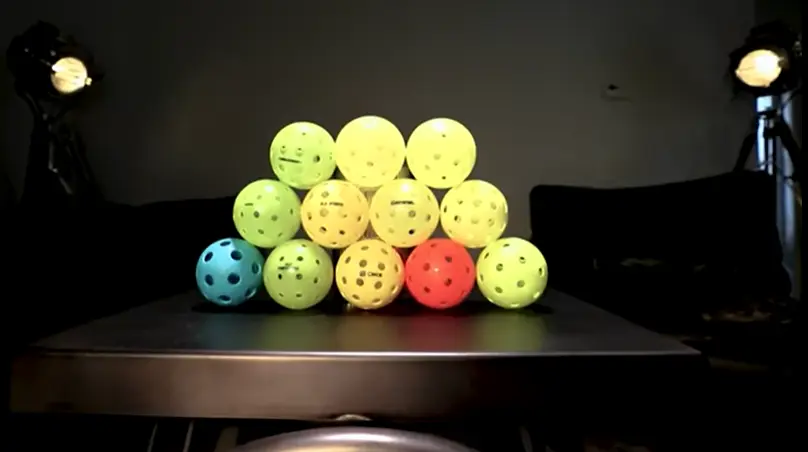Imagine stepping onto the court, feeling the adrenaline rush through your veins, and realizing that you have the perfect pickleball for the setting.
Picture yourself effortlessly maneuvering the ball, adapting to different conditions, and dominating your opponents. Sounds like a dream, right? Well, I’m here to make that dream a reality.

Do Not Forget to Read: Overall Best Pickleball Paddles
In this article, we’ll explore the ins and outs of indoor and outdoor pickleball balls, giving you the knowledge and confidence to choose the right ball for any situation.
We’ll delve into the nuances of hole quantity and size, the impact of climate and court surface, and the distinct characteristics of these balls, such as weight, hardness, texture, and durability.
But hey, this won’t be your typical dry and technical read. I’ll be sharing personal experiences, opinions, and even some practical test results to make things more relatable and engaging. After all, who wants to read a robotic and boring article? Not us, right?
What Is The Difference Between Indoor And Outdoor Pickleball Balls
Whether played indoors or outdoors, the choice of pickleball balls can significantly impact the game experience.
Understanding the differences between indoor and outdoor pickleball balls is crucial for players to select the appropriate ball for their playing environment and skill level.
Size and Hole Patterns:
Indoor pickleball balls are designed with larger holes and fewer in number compared to outdoor balls. Typically, indoor pickleballs have around 26 holes, while outdoor pickleballs feature approximately 40 holes.
Moreover, the diameter of the holes in indoor balls is wider than that of outdoor balls. These variations in hole patterns influence the ball’s performance attributes, such as speed, control, and bounce.
Weight and Hardness:

Outdoor pickleballs are generally heavier than indoor balls, although the weight difference is minimal. This disparity in weight is primarily due to the larger surface area covered by the holes in indoor balls.
Additionally, hardness can differ between pickleballs, with outdoor balls typically being harder and made of thicker, heavier plastic. The hardness of the ball affects its playing characteristics, as harder balls tend to play faster, while softer balls offer a slower pace and improved control.

Durability and Lifespan:
The durability of pickleballs is influenced by their materials and construction. Harder balls, commonly used in outdoor play, are more prone to cracking and losing their shape over time.
In contrast, indoor pickleballs, with their softer plastics, tend to be more durable. As a result, indoor balls generally last longer than outdoor pickleballs.
Material and Color:
Pickleballs for indoor play are made of a softer plastic, while outdoor balls are crafted from a harder, more durable plastic. The choice of materials affects the ball’s durability, bounce, and speed.
In terms of color, indoor pickleballs are typically bright yellow, ensuring better visibility in indoor environments. On the other hand, outdoor balls can come in yellow, green, or orange, catering to different lighting conditions and enhancing visibility during outdoor play.
Performance Characteristics:
Indoor pickleballs are designed to have a lower bounce and slower speed, making them easier to control. These characteristics make indoor balls well-suited for beginners or smaller playing spaces.

Outdoor pickleballs, with their higher bounce and faster speed, are more suitable for advanced players and larger outdoor courts. The hole patterns and softer plastic of indoor balls also make them less affected by wind, providing a more stable gameplay experience.
Indoor Pickleball Balls
Indoor pickleball balls are specifically designed for play within indoor courts and gyms. They possess unique attributes that make them suitable for such controlled environments. The first noticeable difference is their lighter weight compared to outdoor balls.
This lighter weight is achieved by using thinner plastic in their construction. The reduced weight allows players to maneuver the ball with greater ease and finesse.
Another distinguishing feature of indoor pickleballs is the larger holes present on their surface. These larger holes contribute to a softer feel and enhance the player’s ability to control the ball.
The increased surface area also allows for better grip and spin, enabling players to execute more intricate shots and strategies. Additionally, the larger holes result in slower ball movement, leading to longer rallies during indoor play.
However, it is important to note that indoor pickleballs are not designed to withstand outdoor conditions. Their lightweight and slower nature make them unsuitable for outdoor play, especially in windy environments. Attempting to use indoor pickleballs outdoors may result in difficulty controlling the ball and adversely affect the overall gameplay.
Further Information: How To Volley In Pickleball
Outdoor Pickleball Balls
On the other hand, outdoor pickleball balls are specifically engineered to endure the rigors of outdoor play.
They are designed to withstand rough surfaces and challenging outdoor conditions. Unlike their indoor counterparts, outdoor pickleballs are constructed with thicker plastic, making them more durable and resilient.
Outdoor pickleballs feature smaller holes on their surface, contributing to their ability to resist wind interference. The reduced size of the holes helps minimize the impact of wind on the ball’s trajectory, allowing for more consistent shots.
These balls are also slightly heavier than indoor balls, providing players with added power and speed in their shots.
The combination of a harder surface and smaller holes allows outdoor pickleballs to travel faster through the air, resulting in a more dynamic and energetic gameplay experience.
However, it’s worth noting that outdoor pickleballs may experience cracking and misshaping, particularly in colder weather conditions. As a result, it is advisable to keep backup balls on hand to ensure uninterrupted play during outdoor sessions.
Further Information: Does Pickleball Damage Tennis Courts?
Choosing the Right Pickleball for the Game
Selecting the appropriate pickleball for the playing conditions is crucial to optimize gameplay and enhance the overall experience. When playing indoors, it is recommended to use indoor pickleballs specifically designed for indoor courts and gyms.
The softer feel, better control, and slower movement of indoor balls are well-suited for these controlled environments, enabling players to engage in longer rallies and execute precise shots.

Conversely, outdoor pickleballs are the preferred choice for outdoor play. Their durability, resistance to wind, and faster speed make them well-suited for the demands of outdoor courts.
While it is possible to use outdoor balls indoors, their harder surface and increased weight can make them more challenging to control and potentially cause damage to the playing area.
Meeting Standards: Approved Pickleball Requirements
To ensure fairness and consistency in the sport, pickleballs must meet specific requirements set by the USA Pickleball Association (USAPA).
These requirements include standards for size, weight, bounce, hardness, and hole count. Approved pickleballs must have a uniform color and display the manufacturer’s branding. The diameter of a pickleball should fall within the range of 2.87 to 2.97 inches, and the weight should be between 0.78 and 0.935 ounces.
The bounce of a pickleball, which measures its rebound height, should be between 30 and 34 inches. The hardness of the ball, measured on the Durometer D scale, should range from 40 to 50.
Additionally, the number of holes in a pickleball can vary, with indoor balls typically having 26 holes and outdoor balls having 40 holes.
Can Outdoor Pickleballs be Used Indoors?
Outdoor pickleballs, specifically designed for outdoor play, can technically be used indoors. However, there are certain considerations to keep in mind when using outdoor pickleballs in indoor settings.
Outdoor balls have distinct characteristics such as thicker plastic, smaller holes, and a heavier weight that make them better suited for outdoor play. When used indoors, these attributes can pose challenges.
The harder surface of outdoor pickleballs may cause more damage to the playing area, such as scuffs or marks on the floor.
Additionally, the increased weight and smaller holes can make them more difficult to control, potentially affecting the precision of shots and overall gameplay.
While using outdoor pickleballs indoors is possible, it is generally recommended to use indoor pickleballs for indoor play, as they are specifically designed for the controlled environment and provide a better playing experience in terms of control, softness, and slower movement.
Further Information: Can You Play Pickleball On A Tennis Court
Conclusion
Choosing the right pickleball is essential for an optimal playing experience. Indoor pickleballs with larger holes, lighter weight, and softer plastic are perfect for indoor courts, offering better control and slower movement.
Outdoor pickleballs, designed with smaller holes, thicker plastic, and more weight, excel in outdoor play with faster shots and durability on rough surfaces. It’s recommended to use indoor pickleballs indoors and outdoor pickleballs outdoors to maximize gameplay.
So, next time you step onto the court, armed with the knowledge of the differences between indoor and outdoor pickleball balls, you’ll be equipped to make the right choice and elevate your game to new heights.
Embrace the unique characteristics of each ball, adapt to the playing conditions, and let the pickleball magic unfold. Happy playing!

Michael Stevenson
Hi, my name is Michael Stevenson and I’m a passionate pickleball player. I’ve been playing the game for many years and I’m pretty highly skilled at it. Pickleball is one of my favorite topics so naturally, I love to write about it.
Whether it’s tips for beginners, guides for experts, reviews of new paddles, or advanced playing techniques – if it relates to pickleball then I have something interesting to write about it. So if you’re looking for entertaining and informative information on the topic of pickleball, look no further than my written works!